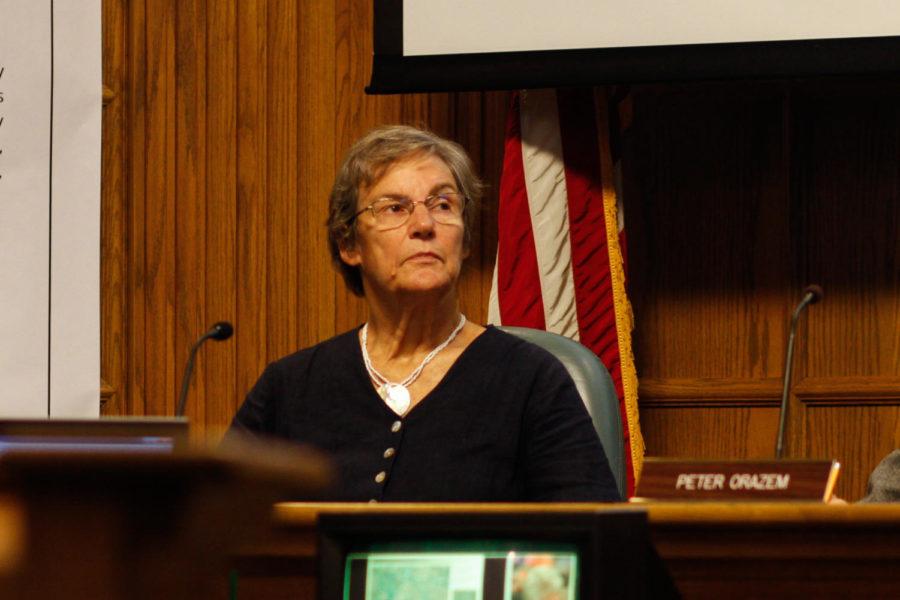- App Content
- App Content / News
- News
- News / Politics And Administration
- News / Politics And Administration / City
City Council approves improvements to South Duff
Ann Campbell, mayor of Ames, looks at a projection of possible new bike lanes on Sept. 20. The big focus of the Sept. 20 meeting was where new bike lanes would be installed south of Iowa State University.
March 28, 2017
The Ames City Council opened its Tuesday night meeting with a special recognition and proclamation by Mayor Ann Campbell.
Two young people from Ames were recognized by Campbell as the Boys and Girls Club of Story County “Youth of the Year” and “Junior Youth of the Year.”
Maliek D. was chosen as the “Youth of the Year” and Emma Clark as “Junior Youth of the Year.” The Boys and Girls club chose them for demonstrating the three pillars of the club: academics, healthy lifestyle and character development.
The two were handed awards from the mayor and given time to speak during the meeting.
Campbell also proclaimed April 2017 as “Good Neighbor Emergency Assistance Month” to recognize efforts by GNEA in the city.
GNEA is an organization that provides emergency rent, utility and food assistance to Story County residents.
Campbell said the group helped show that Ames is a caring community that supports those in need.
A majority of the meeting was spent debating a proposed improvement to South Duff Avenue between South 5th Street and the Squaw Creek Bridge.
The improvement as proposed would install a raised median in the area, build a traffic signal approximately one-eighth of a mile south of South 5th Street and reconfigure Wal-Mart’s west parking lot to allow for cross access for the east-side businesses.
The city estimates that this improvement would lead to a 39 percent reduction in accidents, 24 percent reduction in travel time and a 22 percent increase in fuel economy for those traveling on South Duff.
Jim Howe, owner of Howe’s Welding on South Duff, was present to raise concerns he had with the improvement.
Howe first shared details about the type of business his company sees and the issues raising a median and adding a traffic light could make.
Howe said the 53-foot semis that deliver metal to his shop would be inconvenienced if they were to make the improvement. The real issue Howe saw, however, was in the 80-foot trucks, which sometimes deliver wind turbine parts to his business. He feels the trucks would not be able to access his property safely if the improvements were made.
“The changes should not put small businesses out of business,” Howe said.
Bill Talbot, an attorney, also raised concerns he had with the proposed improvement.
He believes adding a stoplight and median would lead to an increase in accidents because he thinks these improvements would push traffic into nearby parking lots, resulting in accidents.
Talbot reasoned that the city did not foresee this because its projections only accounted for roadway collisions, not ones in parking lots.
In his argument, Talbot equated traffic control to an art, not a science. Council member Tim Gartin vocally disagreed with this argument during the meeting.
“With all due respect, it’s not an art,” Gartin said. “Sometimes it’s got to be about the numbers.”
The motion to go ahead with the improvement passed on a vote of 4-2 in favor.
Council member Bronwyn Beatty-Hansen voiced her opposition to its passage after referring to Howe’s testimony.
”I feel I should stand for the little guy in this one. I can’t in good conscience vote for this,” Beatty-Hansen said.
The meeting saw a third and final passage of multiple ordinances, including one officially creating a Student Affairs Commission.
Once members are appointed, the commission will inform the council on the needs and wants of the student body.







